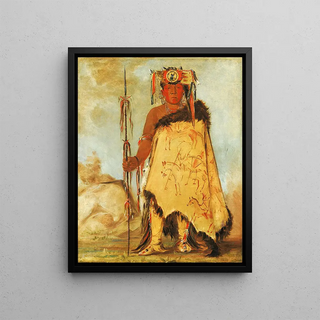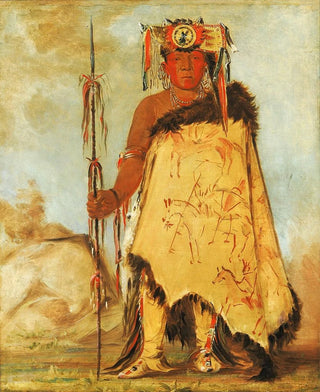Art print | Lawerecooreshawwee, Pawnee Republican war chief - George Catlin


View from behind

Frame (optional)
In the vast panorama of American art, the artwork "Lawerecooreshawwee, Pawnee Republican War Chief" by George Catlin stands out for its authenticity and deep respect for Native American cultures. Created in the 19th century, this painting not only tells the story of an emblematic chief but also embodies the artist's quest to capture the essence of indigenous peoples at a time when their existence was threatened by colonial expansion. Catlin, with his keen eye and artistic sensitivity, immerses us in a world where tradition and the dignity of native peoples are highlighted, offering a reflection on memory and identity.
Style and uniqueness of the work
Catlin's work is distinguished by its vibrant style and refined technique. The rich colors and meticulous details of Lawerecooreshawwee's attire evoke a palpable, almost tangible reality. Every brushstroke seems to tell a story, every shade of color evokes a deep emotion. Catlin aimed to depict not only the physical appearance of his subjects but also their character and culture. In this painting, the expression of the war chief, both proud and resolute, invites us to contemplate the challenges he faced. The composition, centered on the majestic figure of Lawerecooreshawwee, draws the eye and captures attention, emphasizing the importance of the character within the historical and cultural context of the Pawnees.
The artist and his influence
George Catlin, often considered the first painter to dedicate his career to the representation of Native Americans, transcended his era through his artistic vision. Born in 1796, he traveled across the United States to capture the life of indigenous tribes, becoming a valuable witness to a culture on the verge of disappearance. His commitment to the peoples he painted was profound, and he often advocated for their protection and recognition. Catlin's influence extends beyond his works; it also raises awareness about Native American rights, making him an emblematic figure of the artistic movement

Matte finish

View from behind

Frame (optional)
In the vast panorama of American art, the artwork "Lawerecooreshawwee, Pawnee Republican War Chief" by George Catlin stands out for its authenticity and deep respect for Native American cultures. Created in the 19th century, this painting not only tells the story of an emblematic chief but also embodies the artist's quest to capture the essence of indigenous peoples at a time when their existence was threatened by colonial expansion. Catlin, with his keen eye and artistic sensitivity, immerses us in a world where tradition and the dignity of native peoples are highlighted, offering a reflection on memory and identity.
Style and uniqueness of the work
Catlin's work is distinguished by its vibrant style and refined technique. The rich colors and meticulous details of Lawerecooreshawwee's attire evoke a palpable, almost tangible reality. Every brushstroke seems to tell a story, every shade of color evokes a deep emotion. Catlin aimed to depict not only the physical appearance of his subjects but also their character and culture. In this painting, the expression of the war chief, both proud and resolute, invites us to contemplate the challenges he faced. The composition, centered on the majestic figure of Lawerecooreshawwee, draws the eye and captures attention, emphasizing the importance of the character within the historical and cultural context of the Pawnees.
The artist and his influence
George Catlin, often considered the first painter to dedicate his career to the representation of Native Americans, transcended his era through his artistic vision. Born in 1796, he traveled across the United States to capture the life of indigenous tribes, becoming a valuable witness to a culture on the verge of disappearance. His commitment to the peoples he painted was profound, and he often advocated for their protection and recognition. Catlin's influence extends beyond his works; it also raises awareness about Native American rights, making him an emblematic figure of the artistic movement






